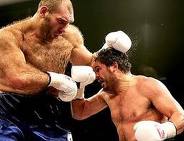There’s an old saying for contests that have degraded into mismatches: “If it were a fight, they’d have had to stop it.” An intensive series of tastings in Italy last week convinced me that one of the most important contests in the world of wine has indeed degraded into a mismatch, and I’m here to stop it.
The contest I have in mind involves the great contenders for the title of world’s Top Middleweight, by which I mean medium-bodied red wine, which is the most important of all wine categories for those of us who care about wine as a partner for food. I enjoy all sorts of wines with different foods, but the most versatile wines of all are medium-bodied reds, as they can pair up with red meats but also white meats, poultry, pasta dishes, hearty preparations of fish, and many other foods.
which is the most important of all wine categories for those of us who care about wine as a partner for food. I enjoy all sorts of wines with different foods, but the most versatile wines of all are medium-bodied reds, as they can pair up with red meats but also white meats, poultry, pasta dishes, hearty preparations of fish, and many other foods.
For years there’s been a tussle at the top of that category between Pinot Noir from Burgundy and Nebbiolo-based wines from Piedmont, but it is no longer a fair fight. Burgundy is down for the count after a one-two punch from the Killer B’s: Barolo and Barbaresco.
My point is not that red Burgundy is in qualitative decline, because it isn’t. The past decade has seen excellent red Burgundy vintages in 2000, 2002, 2005 and 2009. The problem is, rather, that Burgundy’s rarity and international reputation have jacked prices for its better wines up to uncompetitive levels for the vast majority of wine lovers.
If you want delicious red Burgundy, you can find lots of them from the 2009 vintage, but you’d better be prepared to spend $70 to $150. If you’ve got less than $50 per bottle for buying Burgundy, your prospects for getting really good wine are pretty bleak, and you should seriously consider voting with your feet and walking over to the Piedmont section of your favorite wine shop.
Burgundy may have just completed a good decade, but Barolo and  Barbaresco had an even better one, with excellent vintages in 2000, 2001, 2004, 2006 and 2007, very strong vintages in 2005, 2007 and 2009, and a good year in 2008. Despite this amazing run, prices have held steady for the wines, and they are now better at any given price–actually much better–than comparably priced Burgundy.
Barbaresco had an even better one, with excellent vintages in 2000, 2001, 2004, 2006 and 2007, very strong vintages in 2005, 2007 and 2009, and a good year in 2008. Despite this amazing run, prices have held steady for the wines, and they are now better at any given price–actually much better–than comparably priced Burgundy.
This is true at almost any price point, but it is absolutely true in the crucial zone between $30 and $50, which is where most devoted wine lovers are comfortable buying wine on a fairly regular basis. You can test this yourself in a matter of minutes by surfing the web to compare what you can get from national caliber wine retailers for any dollar amount in that range.
From Burgundy, you’ll be limited mostly to rather thin, un-sexy village-level wines rather than single-cru wines from top producers. If you are really lucky and are scraping against that $50 ceiling, you might get a mongrelized Premier Cru wine cobbled together by a negociant from different parcels in a village like Gevrey-Chambertin or Volnay. From Barolo and Barbaresco, however, you’ll have many terrific wines to choose from that were made by top producers from the best single vineyards in all of Piedmont. And while you’re at it, check the point scores that most retailers use to help sell the wines. You’ll see that very few Burgundies crack into the 90s in this price range, whereas many Barolos and Barbarescos rated at 93 or 94 points (by the same publications) can be purchased for $50 or less.
I’m willing to acknowledge that there are still some good red Burgundies available for $50 or less. Indeed, you’ll find that Wine Review Online is a stellar source for finding them, as our Michael Apstein tastes there three or four times each year, and he recommends reasonably affordable wines as well as stunning Grand Cru bottlings. If you love red Burgundy and are willing to work at finding the best of the breed at lower price points, your situation is not totally hopeless.
Nevertheless, if you have an open mind and palate and haven’t been blinded by Burgundy’s mystique, I’m certain that you can find wines with much more complexity, character and consistency for the money  from Barolo and Barbaresco.
from Barolo and Barbaresco.
I love red Burgundy as much as anyone alive, but not enough to pay $125 to get one that can measure up to a Barolo that I can buy for $45. That’s a highly realistic comparison these days, which is to say once again: This is no longer a fair fight, and I–for one–have turned my attention to Piedmont.
Following up on this posting (which is partly a personal screed, but mostly an objective report from a taster who loves Burgundy as much as Barolo), I’ll be back in three weeks with dozens of amazing cases in point among 2007 Barolos and the 2008 Barbarescos. If you wish to argue the point between now and then, please write to me at [email protected]
1
